Starting a grassroots urban farm with little means on a small plot of industrial wasteland with soil so toxic you can’t put any seeds in the ground is no small feat. However, for a small African American community in the Village Bottoms district of West Oakland, being able to feed themselves after decades of urban plight and neglect is at the core of resurrecting their once vibrant neighborhood and healing the wounds of the past.
Two weeks ago, members of Ecocity Builders and the Village Bottoms community transported 20 planter boxes, generously donated by landscape architect Walter Hood at the end of his Canned Spinach exhibit, from the Oakland Museum to the Village Bottoms Farm. In addition to hauling the boxes, we also did some serious winter cleaning to get ready for growing season.
Allow me to share some thoughts and impressions from
OPERATION…
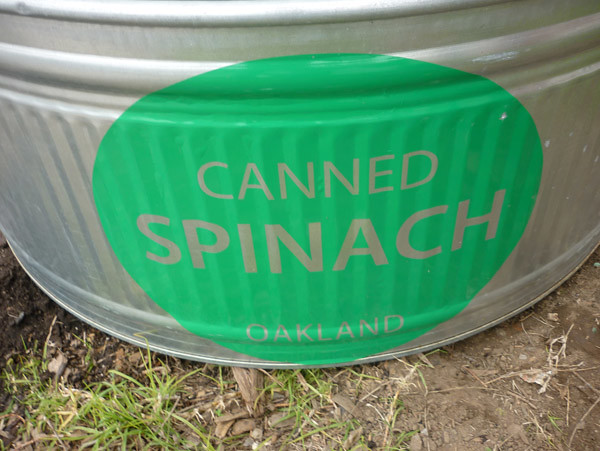
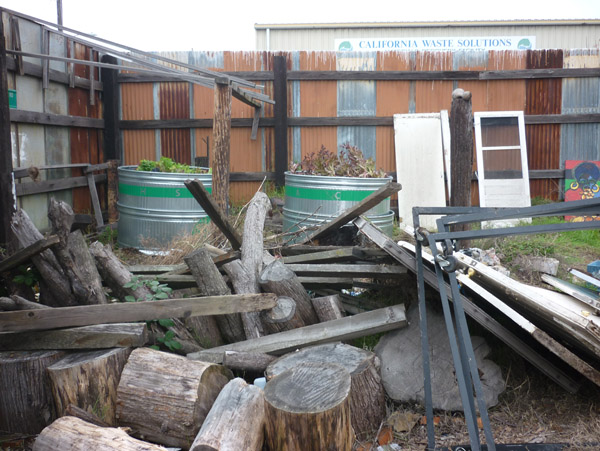

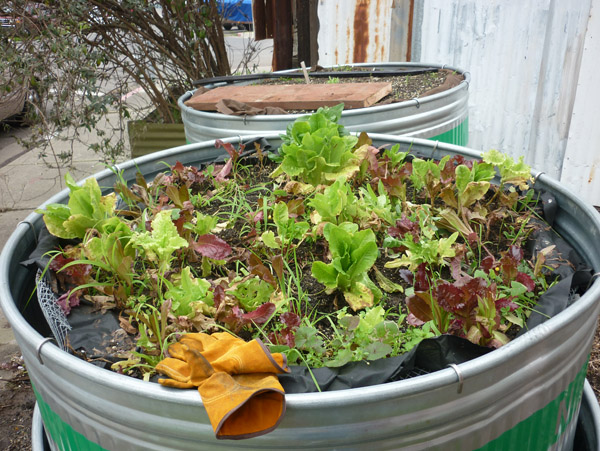
Some background
This is a story that goes back almost a hundred years, chronicling an African American neighborhood through economic booms and busts, urban renewal and its devastating effects on low-income communities, a history of overt and covert racial discrimination, and the unequal environmental burden shouldered by a community with little economic or political clout. Most recently, it’s also a story of revival and hope, coupled with the struggles of healing not only the physical but emotional wounds of decades of isolation and neglect.
I’ve been following and reporting on the efforts to rebuild the Village Bottoms into the thriving neighborhood it once was, long before a freeway, train tracks and other misguided urban planning practices split it apart and took away its economic base. The dream and the goal is to establish it as an African American Cultural District designed around ecovillage principles, and this group of conscious, creative and dedicated black visionaries has been teaming up with ecocity pioneers to embark on one of the most challenging yet also important tasks of our time: the inclusion of and listening to minority and low-income communities in the “greening” of America.
Here’s a summary of what happened so far:
A Brief History of the Village Bottoms neighborhood
Ecocities: From the Bottoms Up
Meet the Community: The Vision
Village Bottoms, Vol. 2: Don’t save us, work with us!
A Tour of Village Bottoms: The Farm, The Coop, The Art, The Music
Village Bottoms, Vol. 3: Getting a taste of what it means to be Black
Growing Pains and Struggles
Justice in the Bottoms? You be the Judge
We Are What We Eat

It’s no secret that the food we put in our bodies has a huge effect on our physical and mental well being. Environmental justice and social justice starts with food justice, as it’s impossible for us to fully function without the right nutrients in our system. It’s no surprise then that growing and providing fresh and local food for the community keeps coming up as one of the pillars of urban revival. Also, as anyone who has ever grown their own food knows, it feels pretty good to know where your food is coming from and it’s empowering to know that you don’t depend on the vast and anonymous agribusiness machine for every bite you put in your mouth. But getting a farm going with very few resources is no small task, as the story of Village Bottoms Farm shows.
They spent a year cleaning up the old junk lot they’d bought for a song, but the problem is that you can’t grow anything in the ground. The soil is so toxic from all the unchecked industrial leakage from years and years of unregulated dumping that you’d be better off eating twinkies all day than anything that would grow out of the soil here. One solution to the problem was Aquaponics: They took a trip to Wisconsin to meet with basketball player turned urban farm guru turned MacArthur Fellowship recipient Will Allen, to learn worm composting, aquaponics construction and other farm skills. Back home, they built their own aquaponics system, a method of growing crops and fish together on re-circulating raised beds.
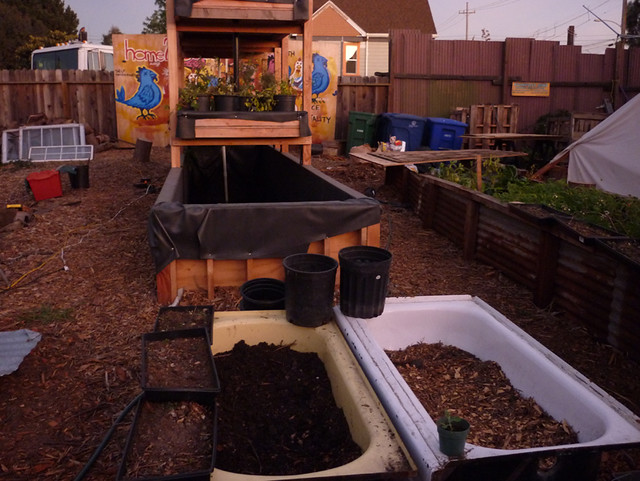
It’s Not Easy Being a Farmer (especially a poor, black, urban one)
But what’s an urban farm without vegetables? Digging up an entire lot and replacing the toxic with clean soil would be prohibitively expensive, if possible at all. And with very little money to begin with and a few grants falling through, the options were limited. So after they had built the entire aquaponic system and were almost ready to go launch their first farming season, the farm went dormant last year. As every grassroots activist knows, the completion of a project often depends on momentum, on getting the right break at the right time that gets people fired up and ready to go, and that just didn’t happen for Village Bottoms Farm last year.
As it turned out, the much-needed break came a few weeks ago, when the above-mentioned Walter Hood, the brilliant landscape architect and artist who is also designing the Center Street pedestrian plaza in Berkeley, donated the 20 planter boxes he had designed for his Canned Spinach Exhibit at the Oakland Museum, an installation revealing the current and historical connection of Oakland’s cultural landscape to the California agrarian landscape, to the farm. How apropos!
Kirstin Miller, the tireless and amazing Executive Director of Ecocity Builders, called a bunch of us volunteers to help with getting the planter boxes from the museum to the farm, and a few days later, it was on:
Operation Canned Spinach
We met in the docking area…
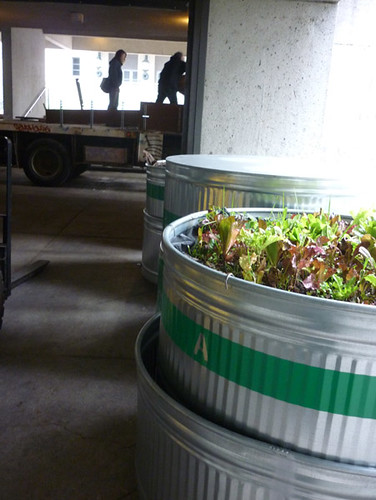

where we loaded up Bob’s truck.

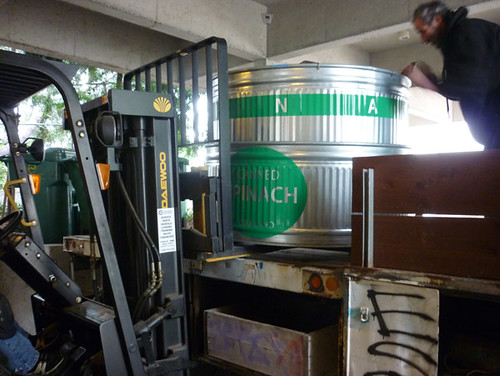
A local scrap metal collector and friend of the farm, we couldn’t have done this without Bob. Success or failure of a project like this sometimes literally comes down to whether you can get access to a truck at the right time. It took several trips through the industrial landscape of West Oakland…
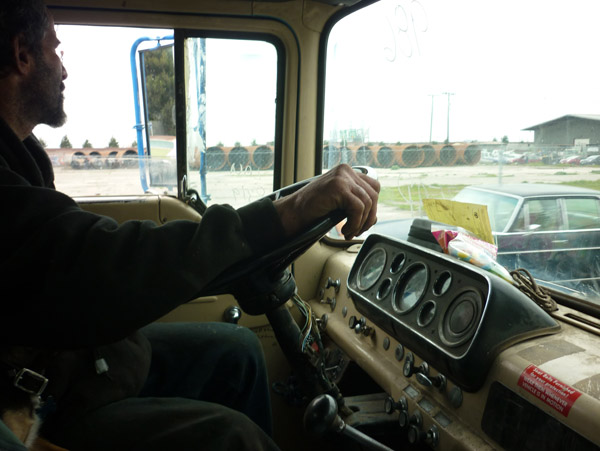
but with some pretty good loading and unloading techniques…
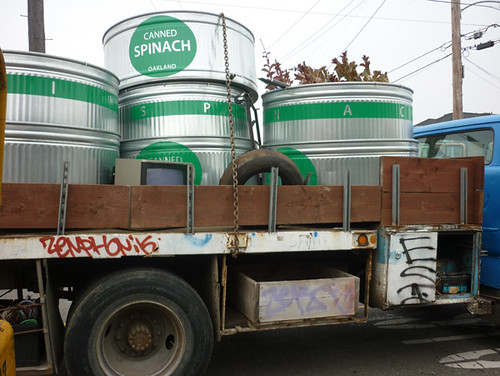
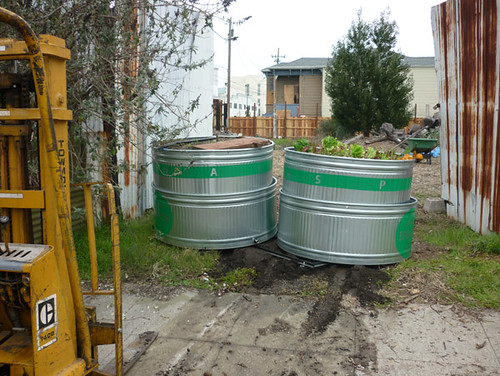
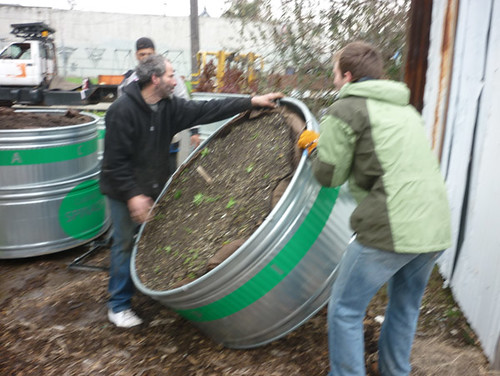
the lot slowly but surely started to look like this:
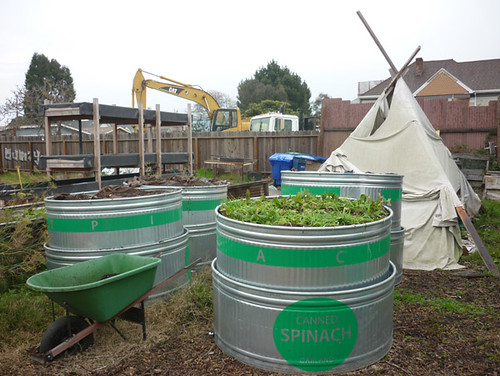
While Bob and crew kept commuting to the museum, the rest of us made ourselves useful. After almost a year of inactivity, the farm needed a little bit of attention.
Kirstin was pitching the plan to our eager cleanup crews…
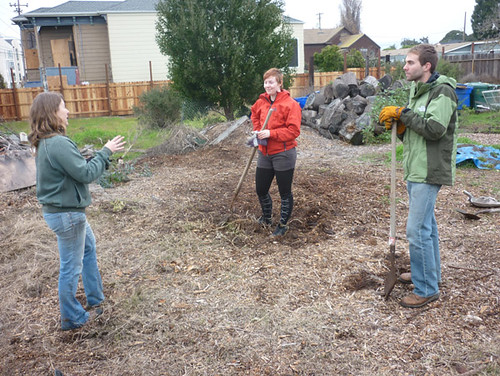
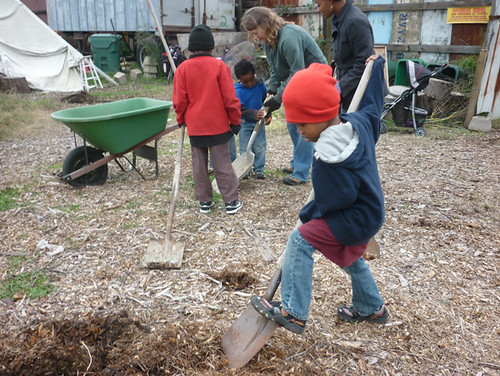
and before we knew it we were leveling out the ground to make room for more canned spinach…
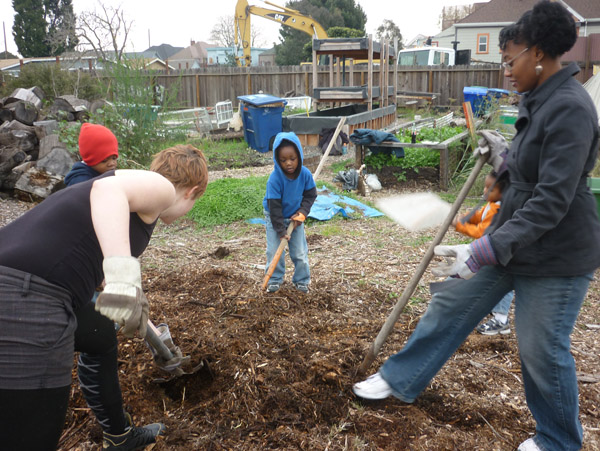
Some techniques needed adjusting…
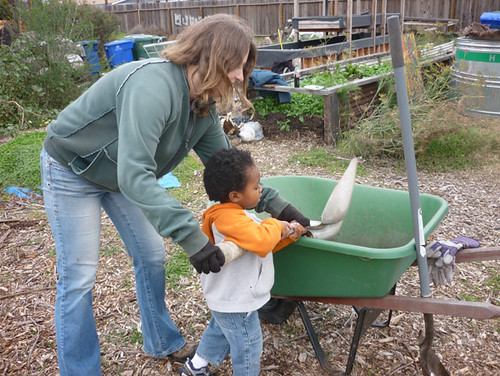
but advice naturally went both ways…
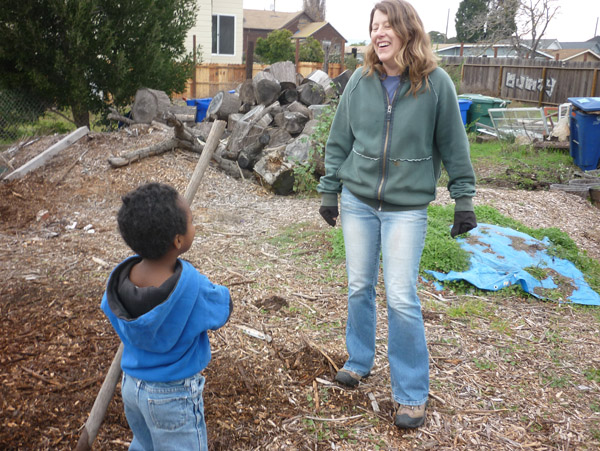
While we had to clean up a lot of trash left behind by folks breaking into the farm…
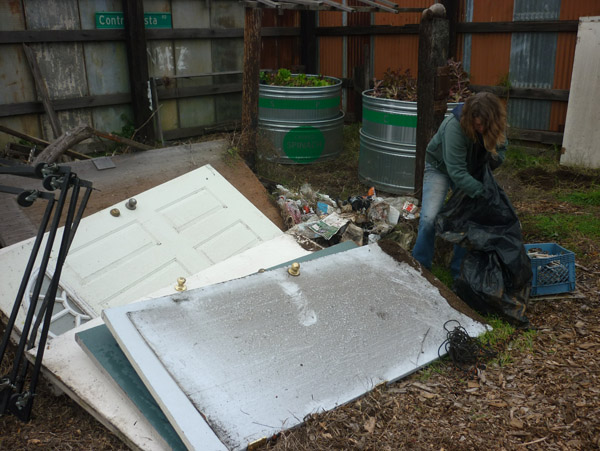
we also used the opportunity to creatively patch up some of the holes left in the fence.
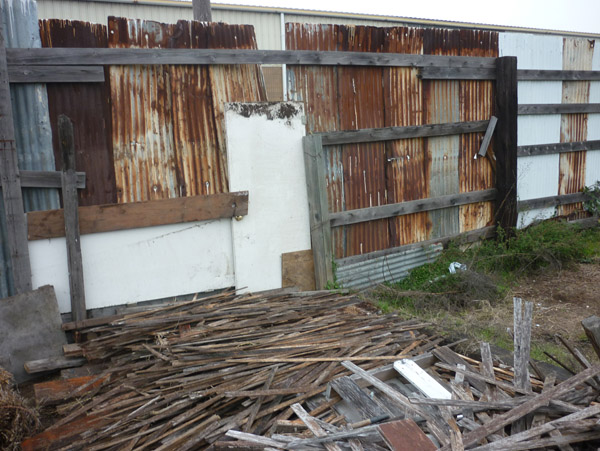
I enjoyed my role as curator!
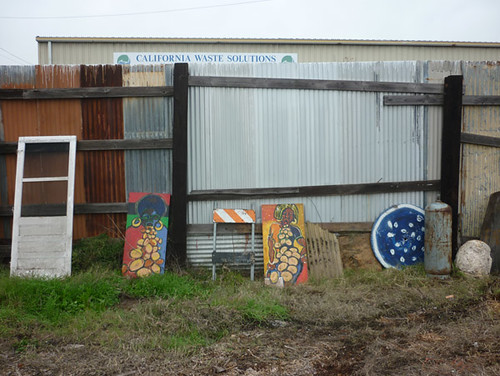

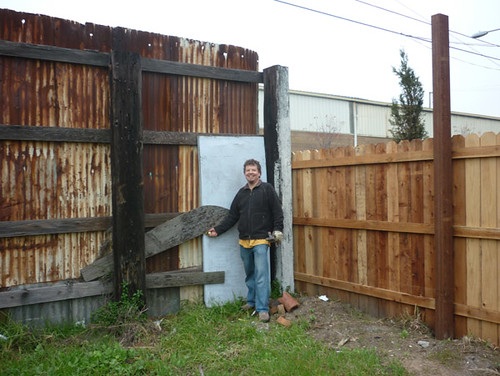
People in the community are pretty psyched about the cans and the cleanup we did. Everybody who stopped by had that spark in their eyes that said, “wow, it’s really happening, we’re ready to roll up our sleeves again and get to work.” Next up will be deciding what to grow in the planter boxes and getting the seedlings going. Get the aquaponics system up and running, for sure. A beehive perhaps? There are ideas of integrating permaculture principles in the whole operation, and we’ve got people with the know-how itching to dig in. Either way, there’s movement in the Bottoms: the community and a bunch of volunteers are ready to get their hands dirty.
The door just reopened. Stay tuned.
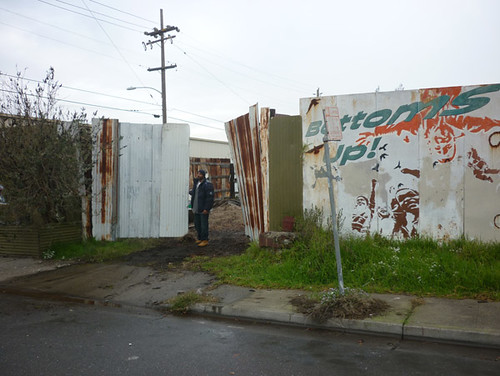
========

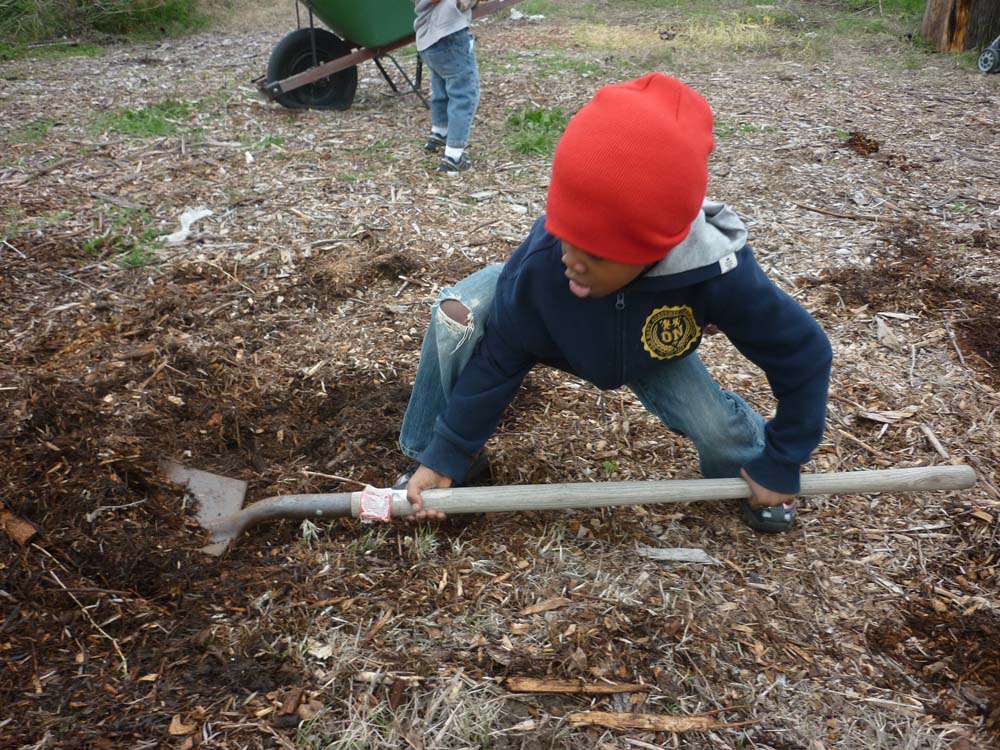






Remarkable story, Sven. I have been following aquaponics since I read an article in our local paper here in Madison WI and did a piece on BPI Campus (http://bpicampus.com/2010/06/19/hemmed-in-green-food/). The University of the Virgin Islands has been involved in a lot of the early research on it.
You have such a great way of capturing what real people are doing to change their world. Thanks for sharing this.
Thanks for the resources, Jan. “High-Energy Meta Mojo Elucidation Detector” – I love it! You should check out Growing Power in Milwaukee some time, I think you can do a tour of their facilities and learn about their Community Food Systems. That’s where the Village Bottoms folks went to learn about aquaponics, after Will Allen had checked out their farm on one of his visits to Oakland.
http://www.growingpower.org
Thanks for that link! What a cool web site.
Once in Berkeley, some people build up a big people s garden…! Remember?
I had a little social satori in Oakland, sitting as only palish sprout in a bus.
Good luck!…spring is coming!
yeah, it was so big it was a PARK! : ) Good times, they still have occasional concerts at People’s Park, but it’s much quieter now than in the 60s.
Good luck with your garden too, may it be a good year for plants.
We seem to have survived this rude winter with almost no heat (a bit of wood in the oven in the evening to cook the food!), big walls of a very old farm, lot s of clothes and blankets, activity,inner storms and laughing.The first green is coming through the earth, and some little winter salad and cabbages are doing well too. The snowdrops points out their little heads too.The cats goes for longer walks. Spring is greeting from far!
I’m ready to recruit people and join the next big work day on the farm!
Yay, awesome!